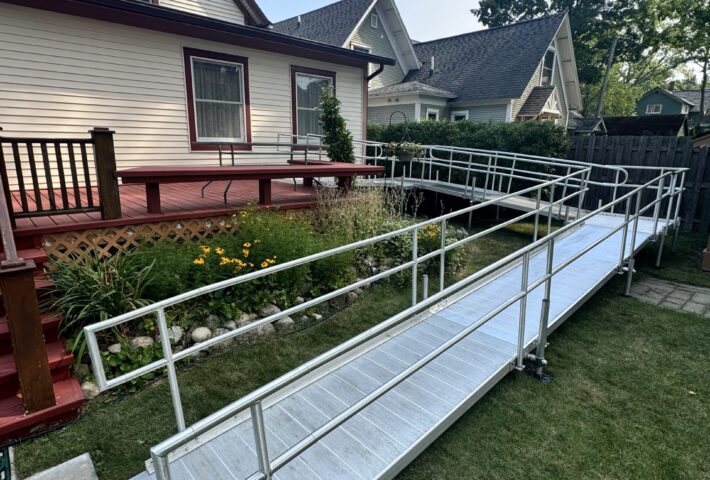
Why ADA-Compliant Ramps Matter: Safety and Accessibility for Seniors
When it comes to ensuring safe, accessible home entryways for seniors and individuals with mobility challenges, the importance of an ADA-compliant ramp cannot be overstated. At Senior Home Solutions, we’ve seen firsthand how many well-intentioned ramp installations fall short…literally. Whether it’s a ramp that’s too steep, too short, or lacks essential features like handrails or platforms, these non-compliant setups can quickly become a serious hazard for the very individuals they’re meant to help.
In this blog post, we’ll explore why ADA compliance isn’t just about following rules—it’s about creating safe, functional access that preserves independence, dignity, and safety. We’ll also break down the dangers of improper ramp design and the advantages of choosing a modular wheelchair ramp system over less secure alternatives like bifolding ramps, even if you are in a time crunch.
The Core of ADA Ramp Requirements: Slope and Safety
One of the most crucial elements in ramp design is the slope, or rise-to-run ratio. According to the Americans with Disabilities Act (ADA), ADA ramp slope guidelines state that the maximum slope for a ramp in new construction is 1:12, meaning for every 1 inch of vertical rise, you need at least 12 inches of ramp run. So, if your entryway is 24 inches above ground, your ramp must be at least 24 feet long.
Unfortunately, many of the ramps we see during consultations are much shorter than this standard. A common scenario: a homeowner installs a 8 foot bifolding ramp to cover a 20-inch rise. That results in a 1:7.5 slope, which is more than twice as steep as it should be. This may not seem like a big deal until you consider how much more difficult—and dangerous—it is for someone in a wheelchair or using a walker to safely ascend or descend a steep ramp.
Why Steep Ramps Are a Serious Hazard
Here’s why a ramp with too steep a slope is more than just inconvenient—it’s outright dangerous:
- Loss of control: When going down a steep ramp, users may not be able to slow or stop their wheelchair in time. This increases the risk of tipping forward or speeding uncontrollably down the slope.This can lead to further injury for the user, complicating their situation even more.
- Strain on caregivers: If a caregiver is assisting, steep ramps make pushing the wheelchair far more physically demanding and unsafe, particularly on inclines where footing can be compromised.
- Injury risk: Without the ability to brake effectively, there’s a much higher chance of falls, collisions, and injury at the base of the ramp or near the entry threshold.
In short, ignoring the ADA ramp slope guidelines is a gamble with a person’s safety and mobility. It’s simply not worth the risk.
Platforms: More Than a Landing Pad
Another essential but often overlooked requirement is the need for level platforms at both the top of the ramp (by the door) and at intervals along longer ramps.
The ADA requires a landing platform at the top and bottom of every ramp. This provides space for maneuvering, door operation, and resting. Additionally, if a ramp run exceeds 30 feet, there must be a platform installed mid-way to allow users a safe place to pause and regroup. These landings are vital for:
- Providing a rest break for users navigating longer inclines
- Allowing room to turn or reposition mobility devices
- Ensuring safety in case a user needs to stop quickly
Without these platforms, even an otherwise well-built ramp can become exhausting or even inaccessible to someone who can’t make it up or down in a single go.
The Modular Advantage: Why System Ramps Are the Smart Choice
At Senior Home Solutions, we always recommend modular wheelchair ramp systems for long-term safety and compliance. Here’s why they stand head and shoulders above alternatives like bifolding ramps or makeshift wooden builds:
1. Consistent ADA Compliance
Modular wheelchair ramps are designed and engineered to meet or exceed ADA and local building codes. Every component from slope, to handrail height, to platform size is tailored to ensure safe, consistent access for those with mobility issues.
2. Handrails Included (and Required)
A proper ramp must include handrails on both sides when the rise is greater than 6 inches. Yet, we often encounter bifolding ramps or DIY solutions with no handrails at all. Without them, users lose a vital safety aid that helps with balance and stability. This creates an area for fall risk without handrail present. All Senior Home Solutions wheelchair ramp systems have bilateral handrail across the entire system.
3. Durable and Weather-Resistant
Modular ramps are made from aluminum or galvanized steel, meaning they are resistant to rust, rot, and warping. Bifolding ramps often use thinner materials that can bend or become unstable with regular use—especially in adverse weather conditions.
4. Adjustable and Reusable
Modular ramps can be easily customized to fit your home’s specific entryway and reconfigured if needs change. They’re also reusable, which is a significant cost saver if a ramp is temporarily needed or must be relocated.
Bifolding Ramps: A Temporary Fix, Not a Long-Term Solution
While bifolding ramps might seem like a convenient, portable option, they come with serious limitations if not used properly:
- No handrails
- Too short for safe slope
- Less stable under heavy weight
- Difficult to secure to the ground
- Not intended for frequent or permanent use
They may work for very low-rise thresholds or temporary loading situations, but for any primary entry point to a home, they fall well short of the safety and security provided by a modular ramp system.
Peace of Mind Through Proper Installation
Most of the time when we see a ramp not up to ADA standards during an evaluation, it is because the customer thought they had no other choice. Their loved one was being discharged or coming home from rehab unexpectedly and they believed there was no other option.
Senior Home Solutions is an compliant ADA contractor. We provide quick wheelchair ramp rental installations to prevent these situations from happening. Our wheelchair ramps are installed within 24-48 hours after initial contact with customers, giving them peace of mind they can get their loved ones in the house safely.
At Senior Home Solutions, our team is trained to assess your home and provide custom ramp installations that are fully ADA-compliant. We take into account your entry height, available space, and any specific mobility needs to deliver a wheelchair ramp that suits all your needs.
Final Thoughts
The difference between a safe, functional ADA compliant ramp and a dangerous, non-compliant one can be measured in just a few feet of extra length, or a couple inches of missing handrail. But those small differences have big impacts on safety, usability, and peace of mind.
If your home (or a loved one’s) needs ramp access, don’t cut corners. Let us at Senior Home Solutions help you design and install a system that meets all ADA ramp standards and protects those you care about most. After all, accessibility should never be an afterthought.
Need a home accessibility assessment? Contact Senior Home Solutions today for a free consultation and find out how we can make your entryways safer, smarter, and ADA-compliant.



